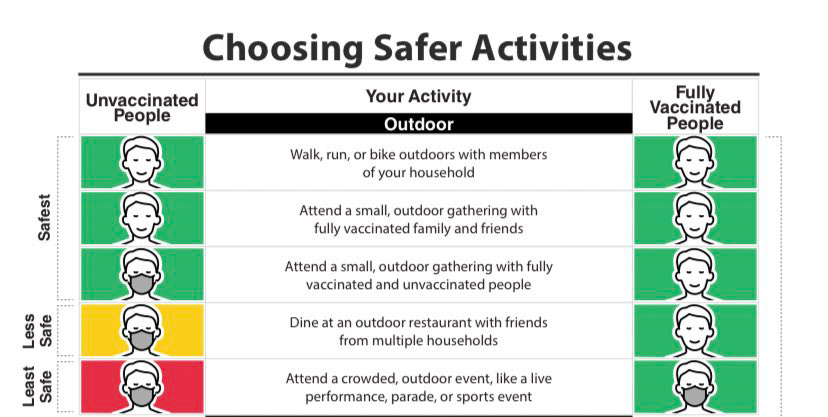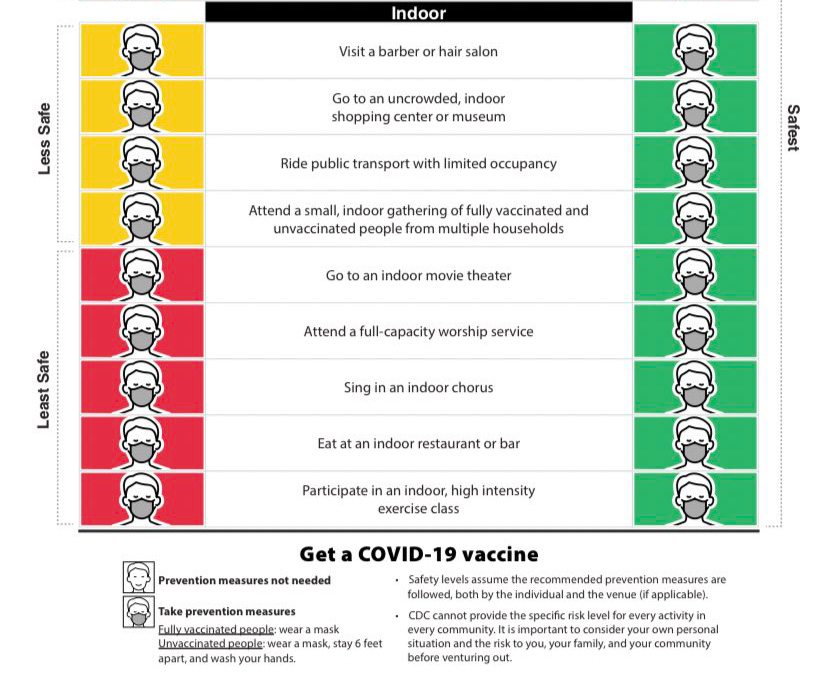New CDC Mask Guidance Won’t Impact Disney World
New face mask guidance from the United States Centers for Disease Control and Prevention is the latest set of recommendations for fully vaccinated and unvaccinated people. In this post, we’ll take a look at the updated April 27, 2021 guidelines, plus what this means–or doesn’t–for Walt Disney World.
The CDC’s new guidelines address growing calls from infectious-disease and other public health experts to relax outdoor mask mandates. This is because breezes disperse airborne virus particles, distancing is easier, and weather makes transmission less viable. In fact, the CDC itself has long offered more relaxed advice for outdoor activities versus indoor ones.
For that reason, the new CDC guidance states that fully vaccinated Americans can go without masks outdoors when walking, jogging, or biking outdoors, dining with friends at outdoor restaurants, and having small outdoor gatherings with a mix of vaccinated and unvaccinated people. Even unvaccinated individuals may go without masks when walking, jogging or biking outdoors, which should bring an end to outdoor mask mandates in many public spaces. That’s pretty much where the good news ends…
Despite literally every activity on the CDC’s chart being labeled “safest” for fully vaccinated individuals, the agency continues to urge caution about crowded outdoor settings and advises everyone, whether vaccinated or unvaccinated, to wear face masks.
Specific examples provided where face masks should be worn outdoors include sporting events, live performances, and parades. It should go without saying, but Walt Disney World and other theme parks would quite clearly fall into this category, as well. See below:
The new recommendations come as over 52% of adults in the United States have gotten at least one shot and nearly 100 million Americans are fully vaccinated. However, vaccine supply has begun to exceed demand, with the average daily vaccinations in the United States starting to decrease, despite wider eligibility and availability.
These changes also come as a growing body of scientific evidence indicates that the vaccines prevent asymptomatic infections, and by extension, transmission to others. The new guidance is thus aimed at helping the fully inoculated ease back into daily routines while encouraging others to get their shots.
Here is the updated guidance for indoor activities for unvaccinated (left) v. vaccinated (right) individuals:
“Taking steps toward relaxing certain measures for vaccinated people may help improve coronavirus vaccine acceptance and uptake,” the guidance states. “Therefore, there are several activities that fully vaccinated people can resume now, at low risk to themselves, while being mindful of the potential risk of transmitting the disease to others.”
CDC officials during a press conference conveyed the message that if you’re vaccinated, you can return to a more normal lifestyle. If you’re not vaccinated, you’re still in danger. The idea is using positive messaging as a “carrot” to incentivize vaccine uptake.
If the goal is motivating people to get vaccinated, it’s unclear whether this updated guidance will prove successful. While the chart shows a sea of green for fully vaccinated individuals, indicating virtually every activity is safe for them, it also recommends masking in such scenarios.
It’s also worth noting that this really isn’t a huge change, as the CDC did not previously recommend masks be worn outdoors. To the contrary, the agency’s website had advised that “masks may not be necessary when you are outside by yourself away from others, or with people who live in your household.” Even though state and local mask mandates often have lacked such a distinction, CDC recommendations have always differed for indoor v. outdoor activities.
There have been countless studies demonstrating that the risk of transmission is dramatically lower in outdoor settings, with the single biggest risk factor being time spent indoors. In one database of over 1,200 coronavirus super-spreader events, just one incident is classified as outdoor transmission.
In another systematic review of outdoor transmission, researchers concluded that less than 10% of reported cases occurred in outdoor settings and that the odds of indoor transmission are 18.7 times higher than outdoor transmission.
“The data are overwhelming that the real risk is indoors,” said John Brooks of the CDC. This may not be news to regular readers of this blog, as we’ve been pointing to these studies since last July. This is not a new development; the CDC is just finally acknowledging the scientific consensus from last summer.
That’s been the “theme” of this month, with the CDC also finally acknowledging that the risk of infection via surface transmission is low—less than 1 in 10,000! That came nearly a full year after most epidemiologists and public health experts concluded that fomite transmission is minor, unlikely, and exaggerated. (We’ve also repeatedly pointed out that the vast majority of cases–over 70%!— are a result of “living room spread“ during household gatherings.)
The CDC has been slow to update its advice as the science evolves, but the CDC guidance is exactly that–voluntary guidelines. The agency weighs the totality of circumstances with the aim of helping state and local leaders, as well as businesses, craft their own mandates and rules. That’s why there are a range of different rules among and even within different states.
CDC guidance is significant with regard to Walt Disney World because the company has relied upon CDC recommendations when creating or modifying its rules. Disney also looks to the local government in Orange County, which is currently weighing a timeline to phase out some restrictions, including face masks and physical distancing.
As we’ve stated previously, any new CDC guidance has the potential to be a game-changer for Walt Disney World. However, that’s only the case when the recommendations apply to both the vaccinated and unvaccinated. This is because Disney does not, and will not, distinguish between the two.
In practice, this comes down to logistics. Having two classes of guests that would be a nightmare scenario for enforcement, and overly burdensome to frontline Cast Members. Walt Disney World already has significant issues with employee morale and turnover as a result of enforcing face mask rules; that would only worsen if Cast Members were tasked with determining who is “eligible” to go mask-less in the parks. Even if the company wanted to do so (and there’s ample evidence it does not), it’s simply not practical. There’s no sense in debating this–it’s a non starter.
It’s also irrelevant–at least for now, as the CDC’s new guidance concerning outdoor masking stops short of advising that fully vaccinated individuals can go mask-less outdoors in theme parks. To the contrary, everyone is still advised to wear masks in potentially crowded settings where physical distancing may not always be possible, which unquestionably includes Walt Disney World.
This new guidance was teased yesterday, and we reported on its potential implications then in an update to our Quarantine Rules, Progress & Guidance for Vaccinated Travelers to Walt Disney World. As you can probably glean by reading that versus this, our expectations were for something a little more substantive and consequential.
While the CDC’s slow roll on rule relaxation doesn’t go as far as we’d like, we also have to concede that the agency is in an unenviable position. Although encouraging vaccine uptake is an important goal, there’s still the reality that case numbers remain high as compared to last summer and fall. The CDC thus is trying to thread the needle delicately. That’s no easy task, especially when everyone–including random Disney bloggers–has an opinion on how and what they should be doing.
With that said, both the CDC guidance, local mandates, and rules established by businesses will continue to evolve. While this is always framed as being driven by the science, that’s a bit disingenuous. Were it true, outdoor mask mandates would’ve been loosened a while ago for everyone and indoor guidance would be further relaxed for fully vaccinated individuals.
Perhaps more accurately, CDC guidance is being driven by science plus objectives and numbers–both in terms of cases and vaccinations. As the former continues to fall and the latter rises, we can expect more changes and normalcy returning. Right now, it’s a tough balancing act in trying to incentivize vaccinations while being cautious given current numbers and the percentage of the population that doesn’t have some form of immunity. Respected public health experts, including former FDA commissioner Dr. Scott Gottlieb, are predicting that the United States is now ending its final surge, with cases to plummet in May. If that proves true, it’s possible that most rules will be fully relaxed sometime this summer.








